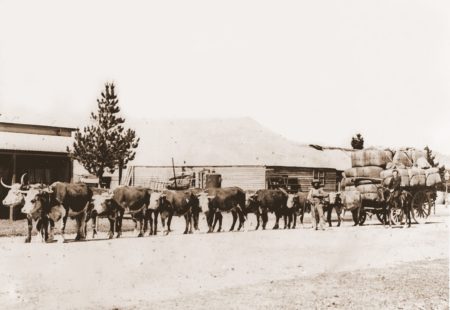
Freight wagon pulled by six yoke of oxen. Crossing sandy creeks was a difficult process often taking two or three days with a long freight train. (Wikipedia)
I recently saw a listing of Spring Sightings that remind us springtime has arrived. There in the middle of the list was the phrase “Pot holes”. Really? It’s possible. Every spring it seems our favorite streets often look like battle zones where bombs carved out giant holes. We hear on the news, read in newspapers and on social media about the sorry state of our infrastructure throughout the country.
Later this spring or during the summer, road crews will pour gravel and dirt into the holes, and then cover them with a hot tar mixture. We’ll have somewhat smooth roads until the rains again wash the mixture down the drain. But is this a recent phenomenon or has it been around forever?
The earliest trails or roads in our country were actually footpaths first used by Native Americans. Later these paths were widened by about two feet, cleared of trees along the route, and called roads. Since most of these newly widened paths were used by the army, they became Military Roads running from the Gulf of Mexico to the Canadian border and from the Atlantic Ocean to the Mississippi River.
After many Native Americans were removed to an area that became known as Indian Territory, the U. S. Military built roads across the Territory to connect with new military forts. During the Republic of Texas (1836-1846) the Texas Legislature conceived the idea to create the Central National Road to connect the U. S. roads at the Red River with the new Texas capital in Austin. Several surveying teams were organized to lay out the new road, cut trees almost down to the ground, and connect with other surveying teams. One such portion of the Central National Road crossed the northwest corner of Hunt County. For their work, the men who surveyed and cleared the road were given Land Certificates for certain amounts of free land for their labors but no actual currency.
As more settlers arrived other roads, such as the Jefferson Road, were created. Wagons loaded with coffee, sugar, salt, clothing, shoes and boots, whiskey, tobacco, medicine, and farm equipment left the river port of Jefferson for trading posts along the way to the Trinity River near present day Dallas. Returning to Jefferson they were laden with wheat, corn, cotton, hides, pork and lard. As many as ten to twelve yoke of oxen pulled the wagons through woods, up hills, across small rivers, and along dirt roads.
Did these large, heavy means of transportation encounter potholes? Yes, along with mud, sand, fallen trees, and any other snags that was imaginable. What did the drovers do? Very simply they altered the route. If they encountered mud holes, potholes, fallen trees or the like, they simply went around forming a new route. No need to fix the potholes, the mud holes would dry up and trees were hewn into firewood. Often the new route would involve clearing trees for a distance. But the wagoners and their oxen were tough creatures.
The coming of the railroad and the decline of the Jefferson Port caused the Jefferson Road to lose traffic. Today nature and humans have basically annihilated the old road. Potholes were a minor interference back then.
